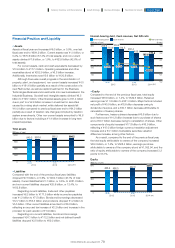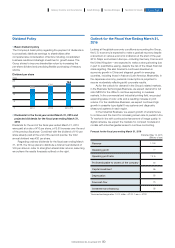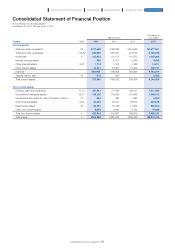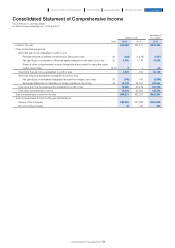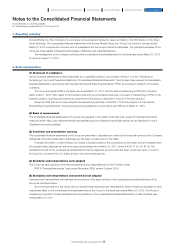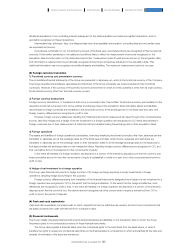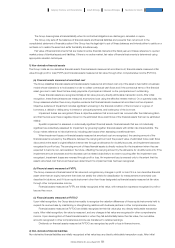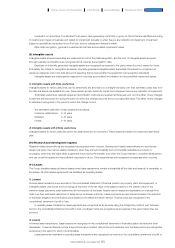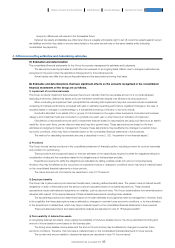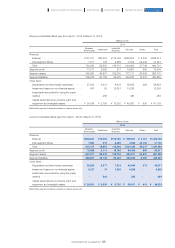Konica Minolta 2015 Annual Report Download - page 90
Download and view the complete annual report
Please find page 90 of the 2015 Konica Minolta annual report below. You can navigate through the pages in the report by either clicking on the pages listed below, or by using the keyword search tool below to find specific information within the annual report.
Standards and
interpretations Title
Mandatory adoption (From fiscal
years beginning on or after)
Fiscal year in which
Company will adopt standard Summary
IAS 19 Employee Benefits July 1, 2014 Fiscal year ending March
31, 2016
Revisions to accounting
related to contributions from
employees or third parties
IAS 16
IAS 38
Property, Plant and
Equipment
Intangible Assets
January 1, 2016 Fiscal year ending March
31, 2017
Clarification of permissible
depreciation and
amortization methods
IFRS 11 Joint Arrangements January 1, 2016 Fiscal year ending March
31, 2017
Accounting for the
acquisition of interest in joint
operations
IFRS 15 Revenue from Contracts
with Customers January 1, 2017 Fiscal year ending March
31, 2018
Revisions to accounting for
revenue recognition
IFRS 9 Financial Instruments January 1, 2018 Fiscal year ending March
31, 2019
Revisions to impairment and
hedge accounting
Significant accounting policies of the Group are described below. These policies have been applied consistently to all fiscal years
presented in the consolidated financial statements.
Exemptions that the Group applied retroactively under IFRS 1 in its transition from Japanese GAAP to IFRS are described in
note 38 “First-time adoption”.
(1) Basis of consolidation
The consolidated financial statements of the Group have been prepared based on the financial statements of the Company and its
subsidiaries and associates, which applied the accounting policies consistently. The financial statements of subsidiaries and
associates have been adjusted when necessary for them to align with the Group accounting policies.
1) Subsidiaries
Subsidiaries are entities controlled by the Group. The Group controls an entity when it is exposed to, or has rights to, variable
returns from its involvement with the entity and has the ability to affect those returns through its power over the entity.
The financial statements of subsidiaries are included in the consolidated financial statements of the Group from the date that
the control commences until the date that the control ceases. In the event that the control continues after the Company has
relinquished a portion of its interest in subsidiaries, this change is accounted for as a transaction with owners. Adjustments to
non-controlling interests and differences with the fair value of consideration are recognized directly in equity as equity attributable to
owners of the Company.
Balances and transactions within the Group, and any unrealized income and expenses arising from these transactions, are
eliminated in preparing the consolidated financial statements.
With regard to the comprehensive income of subsidiaries, even if the balance of non-controlling interests is negative, this
income is attributed to owners of the Company and non-controlling interests respectively based on their proportional ownership.
2) Associates
Associates are those entities in which the Group has significant influence, but not control, over the financial and operating policies of
these entities. Investments in associates are accounted for using the equity method.
Investments in associates are initially recognized at cost. Subsequent to initial recognition, The Group’s share in the profit or
loss and other comprehensive income of associates, is recognized as changes in the Group’s investment in associates from the day
that significant influence commences until the date that significant influence ceases.
(2) Business combinations
The Group accounts for business combinations using the acquisition method, recording as historical cost the total amount of the fair
value of the consideration transferred on the acquisition date and the recognized amount of any non-controlling interests (NCI) in the
acquiree. NCI are measured based on the proportional ownership of their fair value or the fair value of the recognized amount of the
identifiable assets acquired and liabilities assumed.
In the event the total amount of the fair value of consideration transferred, the recognized amount of NCI and the fair value of
the pre-existing interest in the acquiree exceeds the net recognized amount of the identifiable assets acquired and liabilities assumed,
this excess is recognized as goodwill. When the excess is negative, a bargain purchase gain is recognized immediately in profit or loss.
3. Significant accounting policies
89
KONICA MINOLTA, INC. Annual Report 2015
Foundation for GrowthBusiness StrategiesGrowth StrategyCompany Overview and Characteristics Financial Report


